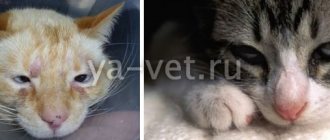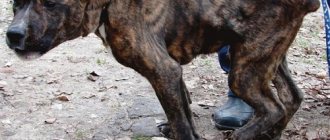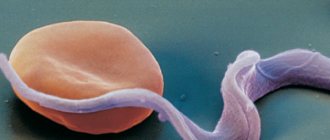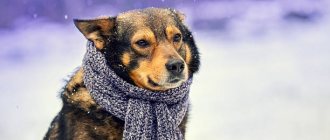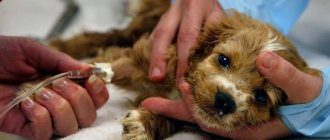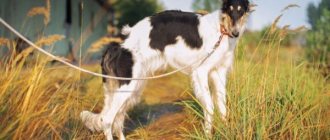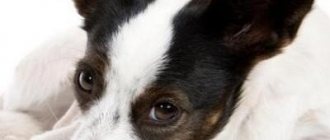Pathogen
Yeast loves secluded, oxygen-deprived interskin folds, where they perform a protective function, preventing staphylococcus from developing. However, when a dog's immune system weakens, fungi begin to actively multiply, causing illness. Malassezia mainly affects older animals. Dogs of the following breeds are predisposed to the disease:
- British Setters;
- cocker spaniels;
- dachshunds;
- German Shepherds;
- individual representatives of lap dogs, poodles, terriers.
Malassezia is not dangerous for humans and other dog breeds.
A characteristic sign of a dog being infected with the Malassezia fungus is otitis media.
Parasitic or flea dermatitis
This type of dermatitis develops when the dog is hypersensitive to the saliva and secretions of fleas (see photo), lice, lice and other ectoparasites. Sometimes just one flea is enough for the dog to start itching frantically, becoming covered in dandruff, rashes, weeping scratches and starting to go bald. Treatment is required for severe forms of the disease; in other cases, it is enough to destroy the fleas.
Symptoms of flea dermatitis:
- the animal itches, tries to bite out the insects biting it, finely clicking its teeth on the skin;
- nodules and blisters with exudate appear at the site of the bites;
- Scratching is noticeable on the skin, the skin thickens;
- Most of the scratching is localized in the area from the lower back to the base of the dog's tail (see photo below).
In some cases, the skin becomes darker or has highly pigmented spots. External signs of flea dermatitis in dogs can be seen in the photo.
Treatment consists of ridding the animal of parasites. If the course is unfavorable, secondary infections may occur and pyoderma may develop. Treating allergic dermatitis with associated infections is much more difficult.
Causes
The main cause of the disease is weakening of the immune system under the influence of the following factors:
- dermatitis of infectious and non-infectious etiology;
- side effects of medications;
- improper or excessive grooming;
- allergic conditions;
- unbalanced diet;
- humid hot weather.
Dermatitis of infectious and non-infectious etiology
All diseases that cause itching lead to scratching. A distinctive feature of long-eared dogs is the excessive accumulation of ear wax, which creates anaerobic conditions favorable for the development of yeast. Among the factors contributing to the activation of micromycetes are the following:
- allergic conditions;
- flea dermatitis;
- ear mite
Malassezia on the face
Side effects of medications
In the treatment of chronic pathologies, steroid drugs are used that cause hormonal imbalance, characterized by itchy skin and hair loss. Long-term use of antibiotics, even if the instructions for their use are not violated, leads to the destruction of yeast competitors - conditionally pathogenic bacteria.
Inadequate or excessive grooming
If you do not comb the hair of long-haired dogs, unexfoliated particles of the epidermis accumulate under it, moisture condenses, that is, conditions are created for the proliferation of yeast. The greatest danger to dogs comes from their mistresses who have not played enough with dolls. Frequent bathing with detergents removes substances from the surface of the skin that protect it from opportunistic microbes.
Unbalanced diet
Vitamin deficiency and imbalance of amino acids in the feed lead to a weakened immune system and an increase in the duration of molting.
Humid hot weather
Dogs do not have sweat glands, so they tolerate heat, especially humid heat, with difficulty. And favorable conditions are created for Malassezia.
Therapeutic techniques
If, in a clinical setting, a diagnosis of “dermatosis” has been unambiguously made, they immediately focus on stopping the effect of allergens: the animal is prescribed antihistamines in loading doses. They allow you to immediately relieve painful itching and stop scratching and scratching of the skin, which can lead to the development of secondary infections. In mild (!) cases, all treatment of dermatosis in cats can be limited only to the prescription of these medications.
In addition, the decision to prescribe additional drugs is made based on the presence of opportunistic infections. The animal is given painkillers and sedatives if it experiences severe pain due to the presence of ulcers, wounds and other injuries on its skin. In these cases, the administration of loading doses of broad-spectrum antibiotics is indicated. But, if possible, they should be selected after titration, that is, determination of the sensitivity of the pathogen. This is precisely why bacterial cultures are grown on nutrient media.
Good results are obtained when anti-inflammatory corticosteroids are prescribed. They allow you to fight both the manifestations of inflammation and itching. But there is one problem here: with long-term use, rapid development of fungal microflora is possible, since these drugs can provoke a serious decrease in immune status. So you should not prescribe and use these drugs yourself: an animal receiving such treatment should be examined weekly by a veterinarian with simultaneous blood sampling. This way you can notice in time that the animal’s body is responding negatively to therapy.
Most likely, a complete recovery will not be achieved: symptoms of the pathology may appear whenever the pet’s health deteriorates and its immunity is weakened. So the cat will have to be given medications throughout his life, albeit occasionally (in the spring and summer, when the likelihood of allergies is highest).
Symptoms
The following symptoms are characteristic of the disease:
- itching and scratching on the face, in the ears, between the fingers;
- seborrhea, peeling skin;
- hair loss, the occurrence of alopecia;
- redness and thickening of the skin;
- sweating of exudate, development of purulent dermatitis;
- unpleasant odor from the dog.
If not properly treated, the dog will lick the affected areas and spread Malassezia throughout the body, because warm, moist saliva is an ideal habitat for yeast.
Malassezia on paws
Treatment of Malassezia
The essence of treatment is to create conditions unfavorable for the further development of a fungal infection. The treatment regimen should be drawn up exclusively by a specialist, and the task of the dog’s owners is to carefully follow it. The impact on the fungus should be complex and include procedures for both local and general effects on the body:
- use of shampoos with chlorhexidine and miconazole;
- the use of antifungal drugs Fluconazole and Ketoconazole;
- if the ears are affected, the drug Otonazole is indicated;
- daily thorough ear cleaning using boric alcohol;
- use of antimycotic ointments “Clotrimazole”, “Nystatin”;
- restoration of the body's resistance with the help of immunomodulating and immunostimulating drugs.
Treatment of Malassezia in dogs lasts from 2 to 5 weeks, depending on the severity of the disease. The treatment process must be carried out under the close supervision of a veterinarian.
Correctly selected treatment will definitely have an effect, and you will soon not recognize your pet: he will become happier, his coat will shine, and his appetite will appear. But know that if your dog has a natural predisposition to Malassezia, then he will receive lifelong immunostimulating and antifungal therapy.
Diagnostics and control measures
Clinical signs of Malassezia resemble microsporia. In the first case, otitis is observed. To clarify the diagnosis, microscopy, cytological and histological examination of the selected pathological material, as well as cultivation of the pathogen on nutrient substrates are carried out.
Therapeutic procedures involve the use of standard regimens for the treatment of mycotic lesions. When local foci are detected, fungicidal ointments, sprays, and shampoos are used. Large-scale lesions require treatment of pathological areas with medications in the form of solutions or tablets. When a yeast infection occurs, otitis media occurs, so close attention should be paid to eliminating inflammation.
The course of treatment for fungal diseases lasts for weeks. Antimycotics have a lot of side effects, so the veterinarian, in addition to treating the underlying disease, prescribes immunomodulators, restoratives, and hepatoprotectors.
Treatment of pyotraumatic dermatitis
Inflammation on the surface of the skin can usually be quickly localized, provided that the dog owner contacts a veterinary clinic as soon as he notices the pathology. Deep pyoderma will require long-term treatment with antibiotics, sometimes with hospitalization at the RosVet VC.
Stages of treatment:
- clean the affected area from hair and exudate;
- dry the inflamed area;
- conduct a course of NSAIDs.
If the area affected by pyotraumatic dermatitis is very painful, treatment is carried out under sedation (general anesthesia) or local anesthesia. This is necessary to thoroughly clean the skin area and minimize stress in the animal.
Clean with antiseptics (chlorhexidine, povidone-iodine, peroxide)
The hair must be cut to cover the healthy area; it is important that the hairs do not fall on the wound surface
If the dog needs to maintain its coat (show, frost), then you can do without cutting, although this method gives a lower percentage of positive results. The wool is washed with shampoos based on benzoyl peroxide or 4% chlorhexidine.
Alternatively, instead of non-steroidal anti-inflammatory drugs (NSAIDs), you can use glucocorticoids in ointments, sprays or systemic prednisolone for 10 days. But this is justified in the absence of a secondary bacterial infection or in its insignificant development.
If papules or pustules are present around the area of inflammation, then the pathological process can be regarded as pyotraumatic folliculitis or furunculosis. Then the prescription of glucocorticoids is not justified, since they provoke an even greater development of the bacterial infection.
If your dog has an inflammation on the skin, don’t hesitate! Call the RosVet VC by phone, 24 hours a day. Make an appointment with a dermatologist and be sure to show your pet. Untimely treatment can lead to damage to the deep layers of the skin, alopecia, tissue necrosis, intoxication and other serious complications.
List of medications
The following dosage forms of drugs are in demand:
- ointments, gels;
- sprays;
- shampoos;
- solutions;
- ear drops;
- pills.
Ointments
The following drugs are in demand:
- Mycozone;
- Clotrimazole.
- Thiabendazole;
- Nystatin;
- .
Clotrimazole
Sprays
Aerosols are sprayed over inflamed areas. If treatment does not bring results, change the drug or prescribe oral medications. The following sprays are in demand:
- Fungin-Forte;
- Lamisil;
- Zoomicol.
Shampoos
They are applied to the affected area for the period specified in the instructions, for example, 10 minutes, and washed off with water. The following drugs are widely used:
- Nizoral;
- Ketonazole/Chlorhexidine;
- Miconazole;
- Beekeeper.
Clotrimazole
Solutions
Used when treatment of large affected areas or the entire dog is required. The following remedies are popular:
- Imaverol;
- Liverazole;
- Zoniton.
Ear drops
Otitis in dogs is rarely caused by a single pathogen. Most often, fungal otitis is combined with parasitism of the ear mite Otodectes. Therefore, drugs should be chosen with multifaceted action. Medicines that contain antimycotics, antiphlogistics, antiseptics, acaricides, and antihistamines work best. Surolan is considered the best drug. An acceptable replacement is Aurikan. Before treatment with the main medicine, the ears are cleaned with boric alcohol.
Surolan
Pills
Oral medications have side effects, so they are prescribed when other medications do not help. The following remedies are popular:
- Griseofulvin;
- Irunin;
- Intraconazole;
- Flucanazole.
Treatment of atopic dermatitis in cats
Treatment of atopic dermatitis in cats is carried out throughout their entire life. It usually includes various procedures that change or adjust the patient's lifestyle. It is often necessary for the owners to make adjustments to the care of their animals. Depending on the severity of the disease and the cat's overall health, an individualized treatment plan is usually developed.
The use of pharmaceuticals should not be a substitute for proper examination of the cat. But symptomatic treatment of itching with glucocorticoids or cyclosporine usually helps ensure patient comfort. Because cats tend to be more resistant to the side effects of glucocorticoid therapy, this form of therapy tends to be used more often than in dogs. But long-term corticosteroid therapy requires baseline testing. Constant monitoring and control by a dermatologist for cats is also important, notifying the cat owner about the prospects and side effects of treatment.
If corticosteroid therapy is continued after the patient has been evaluated, use should be reduced to the lowest possible frequency. Although used quite frequently by some practitioners, long-acting steroids should only be used as a last resort as life-threatening cardiac complications have been reported in 11% of cats. Other systemic side effects include diabetes and urinary tract infection.
Cyclosporine (Atopica) is licensed for use in cats at a dose of 7 mg/kg body weight once daily and may be particularly useful in cats with poor glucocorticoid tolerance or in cats with diabetes. It is very well tolerated by cats, has few side effects, and is effective in cats suffering from allergic skin disease.
Many cats can benefit from pulse therapy to help control symptoms over the long term. This treatment is not recommended for outdoor cats that are carnivorous or eat raw meat, as toxoplasmosis may result from inhibition of T cell function due to cyclosporine.
Pruritus control can also be achieved with antihistamines or essential fatty acid supplements, although rarely do patients have the disease well controlled with these supplements alone. Essential fatty acids may be beneficial due to their synergistic effect when used in combination with other therapies. .
Oclacitinib (Apoquel) therapy has recently been attempted with short-term benefits seen in some patients, but long-term studies or studies in large numbers of cats with atopic dermatitis are lacking. The use of Apoquel in cats is considered an "off-label" therapy.
Allergen-specific immunotherapy is a long-term treatment that is considered safe and 60% to 78% effective. The goal of immunotherapy is to successfully reduce or eliminate clinical signs associated with repeated exposure to causative allergens. Improvement in clinical signs or reduction in the use of antipruritic drugs by 50-100% is usually considered a successful outcome for the patient. Clinical improvement is usually noted within 3-8 months, but may last up to 1 year in some cats.
Elimination and control of allergens is an integral component of managing a cat with atopic dermatitis, just as it is for dogs and humans. The most easily implemented measures to prevent exposure to dust mite allergens are the use of air filters, carpet and mattress treatments, or the use of humidifiers.
Most cats with atopic dermatitis have a good prognosis with reduced allergen exposure, specific immunotherapy, and/or pruritus control to improve comfort and prevent secondary infections. Successful management of these patients usually requires ongoing therapy under the supervision of your veterinary dermatologist.
Signs
- If you notice your pet’s “interest” in any places, take a closer look at them. A dog scratches its ear; it would seem that there is nothing unusual, but if this happens again and again , you need to look into the auricle.
- Sometimes it seems strange to the owner of a four-legged dog that he constantly, regularly and promptly cleans the ear canals, but he fails to clean them completely . Plaque accumulates in the folds of the ear cartilage. It can be from light yellow to brown, and there are also all shades of pink. The deposits are shiny, greasy, one might say “thick”, completely unlike dry scales, without a specific odor. However, when microflora joins the discharge, the smell may change.
- Otitis media can be either unilateral or bilateral . In this case, the intensity of the damage may vary.
- If help is not provided to the dog for a long time, then pustules form on the surface of the serous and mucous membranes, they unite and the entire surface becomes constantly wet. The skin turns blue, purple and runs.
- Along with ear problems, your dog may have an increased interest in the tips of his paws . She licks the space between the toes (mainly on the hind legs). Taking a closer look at the limbs, you can see slightly bald areas of the skin, sometimes they are pink, after intense licking and gnawing, sometimes without changing the natural color.
- The main symptom accompanying the high virulence of the fungus is itching . This is what causes the animal anxiety. It will also help determine the extent of the process and the effectiveness of treatment.
When a dog is sick, it constantly scratches its ear.
If the fungus spreads to the skin, it causes squamous dermatitis.

